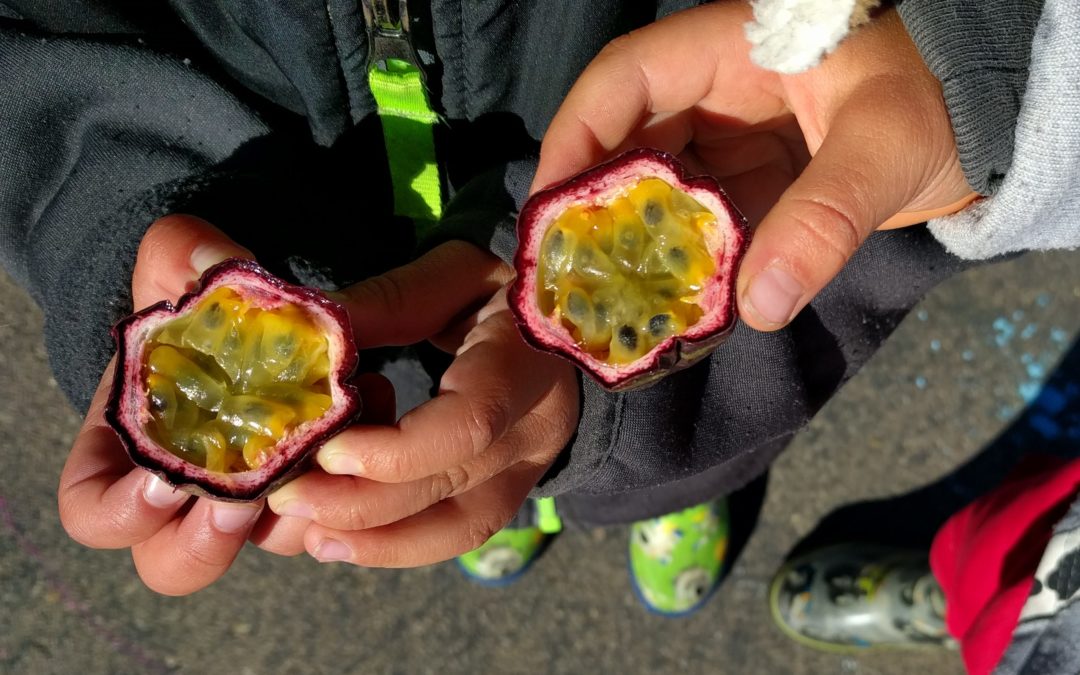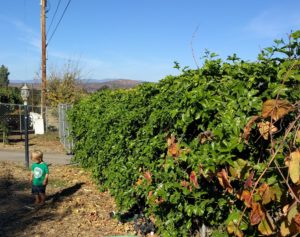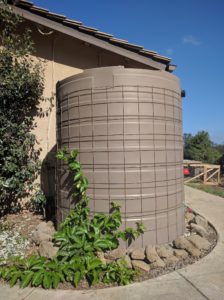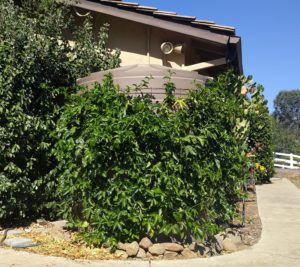I had a problem and passion fruit solved it. I live on a dirt road and my vegetable garden starts only twenty feet from the road. I wanted both privacy and dust catchment. Because there’s a chain link fence between the road and my garden, I was able to plant a passion fruit vine, and it has grown into an edible and evergreen wall.
I’ve since planted more passion fruit vines to cover other fences and a rain tank. Maybe you need something covered — because it’s ugly or for privacy or for dust catchment — and a passion fruit vine can be the solution.
What follows is what I’ve learned about growing passion fruit in Southern California from my own vines as well as those of friends.
More than edible
First and foremost, passion fruit is delicious, tangy sweet, and everyone in my family loves them. My young sons get so excited when they get to eat one of these purple eggs. I give each a half and they lap the pulp up with their tongues (often suctioning the empty rind onto their chins for fun at the end).
I, however, eat my passion fruit by scooping the pulp out with a spoon. (I’m so refined.)
Harvest is year-round. The fruit is not messy when it drops from the vine, as it doesn’t splatter or rot. It lies on the ground getting sweeter and waiting for you to notice it.
I’ve grown four varieties: Frederick, Possum Purple, Red Rover, and Nancy Garrison. They’re all very similar in appearance, growth habit, and taste, but I’ve had the best luck with Frederick and Possum Purple. As far as taste goes, Possum Purple is my slight favorite as it seems to consistently get a little sweeter than the others. That may be particular to my plants in my location though, not sure.
Each is self-fruitful so you don’t need more than one passion fruit vine in order to get fruit. Insects do the pollination work, and honey bees certainly enjoy the flowers. Here is a honey bee on a passion fruit flower on the first day of winter, December 21, 2017:
More than evergreen
Before I settled on a passion fruit vine for privacy and dust catchment on my fence, I’d tried many other plants. I grew tomatoes and trained them up the fence, I let green beans climb it, as well as peas. But I soon learned that I wanted something perennial; I didn’t want to put in new plants every couple months. So I planted blackberries and raspberries. The blackberries and raspberries have now been moved to a spot with afternoon shade, however, because the fence gets all day sun in the summer and sometimes burns the berries. I planted grapes there too, but they have no leaves to provide privacy from December through March, so that didn’t work.
With passion fruit though, the vines look good all year. The leaves are glossy green, although its flowers are the real draw. Blooming in every month of the year, passion flowers are complicated and colorful.
Once a passion fruit vine gets going it will extend over a dozen feet long in a single year’s growth, grabbing onto anything it can with its tendrils. The one plant that I have in front of my vegetables is fully covering 12 strides, or about 30 feet, of fence — would be more except I keep it pruned back. It would probably be twice that length if I never pruned it.
Thankfully, passion fruit vines are enjoyable to prune, having soft leaves and stems. I prune mine at least once a year, often in the late winter, but also often whenever the mood strikes.
I’m in Sunset Zone 20 or 21, and usually once each winter my vines get their tips burnt from a frosty morning. It’s welcome since I’m going to prune them back much further before they start growing intensely again in early spring anyway.
Got light frost this morning, incidentally, with a temperature reading on my porch of 36 degrees (so a few degrees lower out in the yard) and zero damage to passion fruit vines or fruit.
Passion fruit vines don’t seem to care whether they get watered by drippers or sprinklers. I’ve used both with fine results. And I’ve found that watering about once per week in my sandy loam soil is enough during the summer. The neat thing that I’ve stumbled upon with passion fruit vines is that once they get a year old you can continue giving them water often and in high volume and you’ll get lots of fruit, but you can also water them infrequently and with less volume — similar to grapes — and the vines will still look good but produce less fruit.
Cover anything
I had another problem a couple years ago. I put in a rain tank on the south side of our house and wanted to keep it cool and pretty. Another passion fruit vine saved the day. I wrapped the tank in wire mesh and planted a vine in August of 2016.
Within a year, it was covering the tank completely and needing some taming. Here in December of 2017 it looks like this.
Neighbors put up an ugly cinderblock wall? Let a passion fruit vine beautify and edify it. Want a year-round shaded pergola or arbor? Passion fruit. Have a dead tree? Use it as a scaffold for a passion fruit vine to climb.
Want a few more details on passion fruit? Read this passion fruit page from the California Rare Fruit Growers.
All of my Yard Posts are listed HERE










Thanks for the post and great info. I talked to guy at a nursery who said a passion fruit vine will only live (or stay productive) for 3-5 years and I would need to replace it. Is this true? Either way I’m excited to plant some this spring…
I have heard the same thing, and from many different sources, that passion fruit vines are short lived. They say that five years is a good long life for a passion fruit vine, and they say that commercial growers replace their vines after about three years. But it seems that a lot of this information comes from far away places with different growing conditions and disease pressures, places like Australia, Kenya, and South America.
The only real experience I have here in Southern California that might counter it is with my own vines and those of friends. My oldest vine is almost five years old and it’s as healthy and productive as it’s ever been. A friend of mine has a seven year old vine that is doing well, and he also has a healthy and productive one that’s even older although he said he’s not sure exactly how old it is. Still, he said he’s going to root some cuttings this spring because he’s afraid the short-lived claim about passion fruit might be true, so he wants to have a replacement ready.
We planted our first passion fruit almost 10 years ago. Most years there was an abundance of these delicious fruits.It was perfect for privacy and shade. This past summer the leaves just turned brown and died. My court yard was my secret garden and it’s so depressing seeing it so bare.
I’m going to Exotic Nursery in Vista, ca. to buy a couple more.
I have made passion fruit squares, shorbet, bread. I freeze them whole or the pulp.
When I was a little girl I used to live in Puerto Rico and my mom had the vine all over the fence and we love to make “Jugo de Parcha” , now I live in Connecticut and I bought one plant but it died as soon falls start but it did a great 3 months “summer “ vine and beautiful flowers.
How do they fare against the squirrels and rabbits? They seem to think I’m running a buffet just for them…..
Yeah, those greedy squirrels and rabbits. I’ve had to entirely eliminate the squirrel population in my yard in order to eat any of the food I grow. If any neighborly squirrels show up — and they do every summer — I eliminate them immediately. So I don’t know exactly how attracted to passion fruit they are, but I’ve never seen them going after mine more than other fruit.
Rabbits are ever present in my yard though. I’ve found that the only damage they cause is when they nibble the stem of a newly planted vine. So I put chicken wire around those for the first year or so. Rabbits don’t touch the fruit as far as I can tell.
Hi, Greg
May I know how do you eliminate squirrels? We have the same headache.
Thank you for your info ahead !!
Hi Evonne,
I hate talking about this because I don’t have a great answer. I simply trap them and then shoot them with a pellet gun. I wish I knew of a better way, but squirrels are so greedy (they’ll steal every piece of fruit on a tree) and they are so good at climbing that it’s nearly impossible to use barriers effectively.
I am curious as to how you immediately eliminate your squirrel population! We have had SOO MANY SQUIRRELS last year and this year! They ate many immature avocados off my tree this summer and now they are enjoying the pecans in my pecan tree. We live in a neighborhood, so using a pellet gun is tough… only safe to do when we get a good, clean shot towards the ground. Is there another trapping method you’d recommend?
I hate that I have to eliminate the squirrels, but I’ve tried to be friends with them in the past and they just refuse to share. Our first year in this house they literally stole every single plum off our tree — I’m talking hundreds. Zero for us. They took them before they were even ripe.
I’m also talking ground squirrels, the ones native to California (they’re gray), although I battled tree squirrels in my old yard.
I shoot them with a pellet gun sometimes, but in terms of time, that is a very inefficient way to deal with them. Traps work best for me. I use a Havahart trap, which I bait with some kind of nut usually (plums certainly work too!).
But once I have one trapped, I do then shoot it with my pellet gun. I used to drown them in a trash can filled with water but no longer do that because it’s brutal. I now give the squirrel a shot to the head with my pellet gun, which kills it instantly if done right.
Like I said, I hate doing this. I tried barriers and other preventative measures, but they just don’t work for my situation (such as wanting my fruit trees to have low branches).
Hi Greg, I also live in SoCal and would like to start reliable, delicious passion fruit vines. My garden space is small but I would like to train them on an arched trellis over my two vegetable trugs. I can’t find the edible variety in our nurseries here. Would you consider selling me some rooted cuttings from your vines?
Hi Peggy,
I would just give you some rooted cuttings of passion fruit if I had any, but unfortunately I don’t right now.
I’m certain, however, that a nearby nursery can special order passion fruit vines of various edible varieties for you. I’ve done this through Armstrong, for example. There’s probably an Armstrong reasonably close to you if you are in Southern California. Check here: https://www.armstronggarden.com/storelocator/
Even stores in Southern California like Home Depot sell Frederick passion fruit vines, which are productive and tasty. You might try them if you have trouble getting one through a nursery.
Let me know if none of these options work out.
Thanks for responding Greg. I’m on my way to Armstrong right now.
Greg, I found Frederick cultivar at Armstrong but not Possum Purple. They searched several nurseries around the country, found one in Connecticut but they were sold out. So I bought one Frederick and am still on the hunt for Possum Purple. Keeping my fingers crossed!!!
Hi Greg, I have two 4 year old Frederick passion vines in my yard. They produced lots of fruit for two years, but last year I got lots of flowers and almost no fruit, and this year I’m not even getting any flowers! I heavily prune them every February and the new growth appears lush and healthy. They are fertilized monthly and are on a drip irrigation system. Any ideas as to why they’ve stopped producing?
Hi Sarah,
My passion fruit vines haven’t had a good summer either. Here are some possibilities as to why yours aren’t:
This summer was exceptionally hot, and passion fruit vines don’t do great in full sun in an inland location where it sometimes reaches 100. (Not sure where you’re at.) That being said, I’ve seen younger vines in hot inland locations that do fine if they’re watered a lot. It’s surprising how much water an older, larger vine needs in order to maintain good production though. When I’ve skimped on the water, I’ve gotten few fruits, and the fruits I got often had little pulp inside.
So that’s the other thing, water. Water requirements have been higher this summer compared to past years because it’s been hotter, and our soils didn’t get replenished during the winter since there was almost no rain. The passion fruit vines started the spring in a soil moisture deficit.
Your pruning and fertilizing seem right for good passion fruit production.
Maybe if you up the water now in conjunction with the cooler (relatively) weather here in late summer, you’ll get flowering and fruit set and have something to eat in late fall. I’ve had quite a few passion fruits to eat in the late fall in past years so there’s hope for that.
Greg, thanks for responding! I’m located in Lake Forest about 10 miles inland from the coast. I’ll take a look at my irrigation in that area – perhaps it’s just not sufficient anymore for the age of the vines.
Thanks for the great idea! I wanted another edible vine but not another grapevine. If I can find a vine, could I still plant in the fall–just to get the plant to take to the new spot? For the short-term, I am more interested in the vines hiding the neighbors so if it doesn’t fruit til next Spring, I am fine with that.
Hi Shay,
For sure, you can plant a passion fruit vine right now if you live in an “unfrosty” place. I wouldn’t plant one at my house until spring because I usually get a couple frosty mornings each winter and young passion fruit vines get damaged by them. But if you’re closer to the beach or on a slope with good cold-air drainage, it’s probably safe.
Hello! Thanks for the great read! I want to grow some of these in Central California, zip 93247. Zone 9a. It can get over 100 in the summer, but usually it’s around mid to high 90s. Do you think I should use a shade cloth to help with summer heat?
Hi Jason,
I think yours would do best with some minor shade. You could use shade cloth or plant to the east of a large tree or building. I have a passion fruit vine that does well planted to the east of a large oak tree so it doesn’t get full sun after about two o’clock in the summer.
Greg, I have a one year old Frederick grown from a cutting. Sadly it’s taken a whole year and it has only grown to the top of the fence (6 feet) and now starting to vine along the top. Flowered for the first time (2) and one held. Should I remove any fruit this year to encourage more growth? Thanks!
PS Some comments are not posting… copying this one in case it fails
Hi Zen,
I’d let the fruit mature. I’ve had passion fruit vines take some time to start growing much, but once they get established they are beasts. And it sounds like your vine already has enough foliage to support fruit.
It’s starting to branch out. Holding 2 fruits so far, guess I’ll finally get to see what one tastes like! Cheers.
Regarding the die-off question. I’m in coastal San Diego and had a Frederick that was big, healthy and productive. One day when it was 7 years old all the leaves got droopy. Two weeks later the vine was completely dead. It was fast and dramatic – one day it was fine, the next it wasn’t. I was sure a gopher had gotten to it, but the roots were intact when we removed the plant. There didn’t seem to be any rot, insect issues, excess water or apparent diseases – it just died.
Hi Greg,
You said you prune your passionfruit vine hard, could you tell me what that means…are you pruning each vine back 50%, or more than that?
For squirrels, besides the Hav-a-Hart traps, one of the few things that works for me is to put cages around the plants (vegetables) or fruit bunches. This year I had some pears and apples, and even peaches, to myself for the first time by making wire mesh pillowcase shaped/cylindrical baskets(out of aviary wire- 1/2″ chicken wire) and slipping them over a branch, or clump, with fruit on it. I did this last year on a young passionfruit vine, by shaping a cylinder of aviary wire around a section of vine and lacing it up. When you close off the ends it looks like a pillow case. The key thing is to secure the basket, with a wire or rope, to a branch or pipe stuck in the ground (I use 1/2′ conduit/ent pipe). This prevents the squirrel from tearing the basket off the vine (or tree).
Electric fencing also works for squirrels, but probably not a good idea with young kids around.
Hi John,
Thanks for the ideas about squirrel protection.
I prune my passionfruit vines differently. If I need one to stay within a small space, like the vine I have covering a rain tank, then I prune it often but not a lot each time. I usually prune it just as it starts flowering (each flowering round), and I probably end up removing about a third of the vine at the most each time.
But for vines on a fence that have room to spread, I only prune in the spring usually, and I would still remove maybe up to a third of the growth at that time.
Greg, thanks for your article! my neighbor just chopped down my tree illegally and i’m trying to get him to replace it. does this grow HIGHER than the fence it’s creeping on ? He’s building a 2-storey behind me and I’d like a tree that is LOW maintenance that will grow tall quickly, little watering to get started and will grow to at least 15-20′ tall?
Hi Greg,
I’m looking to grow a passion fruit plant in a greenhouse outside Boston. I’ve never done so before. Varieties under consideration are Frederick, Possum Purple and Nancy Garrison. A couple questions for you:
1. Would any of these be ill-fitted for an environment like this?
2. Given that the plant will be indoors, will it still be fruitful? (You mention pollination. Are any of these self-pollinating or will I need to hand pollinate the flowers?)
3. Anything else I should know about growing passion fruit in a greenhouse?
Thanks for your time!
Hi Anna,
I have no firsthand experience with growing passion fruit indoors, but a reliable publication on passion fruit from the California Rare Fruit Growers has answers to your questions: Yes, it grows well indoors. The flowers are self-fruitful but do need pollination by bees or by hand.
Here is the CRFG pub: https://www.crfg.org/pubs/ff/passionfruit.html
I would only warn you that once a passion fruit vine gets growing it really gets growing! It can take over the world so you’ll either want to plan to give it a lot of space or prune heavily, especially in early spring.
As for varieties, all of the ones you mentioned I have grown and liked. And there’s not much difference between them.
Let me know how things go.
What do you think would be the closest spacing you could do with nancy garrisons if you were really tight on space? Thanks
Hi John,
I wouldn’t allow for less than about ten feet of vine growth. On the passion fruit vine that I had on my rain tank, I spent lots of time pruning to keep it back to about a ten-foot spread.
I live in San Marcos zone 10A & purchased some purple fruiting passion fruit about 6 years ago
I’m sorry but I have neglected them at times, although I water fairly regularly & gave them citrus fertilizer 3-4 times a year. The vines look almost dead now. I gave them 1/2″ of earthworm castings & covered that with Dr. Earth mulch, hoping they will come back, but not holding much hope. Is there a variety that is longer lived than what I purchased and can they be ordered through nurseries in North county San Diego?
Aloha Greg,
What sort of wire mesh did you use to surround your rainwater tank?
Mahalo,
Will
Hi Will,
That’s concrete reinforcement mesh. The same stuff I use to build tomato cages.
Will the vine grow along a concrete wall without any trellis ?
Hi Sara,
I don’t know. I’ve never seen it tried. It would depend on how smooth the wall was. The wall would need significant bumps and cracks for the vine’s tendrils to grab onto. A passion fruit vine’s tendrils are similar to a grape vine’s.
I read about passion fruit plants living 5-7 years. I planted Fredericks on a fence on my property, each year I take one of the fruit, dry out the seeds, start a new plant and have put it next to the one from the year before. I’ve done this for the last 4 years, my plan is somewhere between the 5th and 7th year, I’ll dig a hole next to the original and plant a new one. So far so good on the fence I’ve wanted to keep green and loaded with passion fruit. On a hillside in Whittier.
Hi Greg (and everyone who has commented),
Great thread and post. Super timely since I’m looking to slowly remove a pretty thick fence of “creeping fig” at the house we just moved into. The creeping fig has been grown as a privacy fence and grows about a foot and a half to 2 feet above the walls that divide our property from the neighbors’. It is about a foot to a foot and a half deep – way deeper than I’d like it to be.
Unfortunately, I get tree rats all over my veg garden and fruit trees because of this built in rat-highway. I have trapped and caught a bunch of them so I know it’s def tree rats.
My plan was to replace it in sections and add in passion fruit and also star jasmine to provide that year round greenery.
I was wondering if anyone has had issues with rats in their passion fruit vines? I don’t want to replace one rat highway with another 🙂 … I was going to add a few trellis structures along the wall that’s between us and our neighbor so that I can grow the passion fruit up to the top of the trellis and create privacy as I remove the creeping fig.
Any advice or comments welcome!
Thanks!
MB
Hi MB,
I also know firsthand how much rats love creeping fig. My mom has it on her back wall and it is infested with them.
As for passion fruit, I have heard people say rats use it too but I haven’t seen this firsthand.
Hi Greg,
I planted 3 passion fruit vines four months ago and they seem to be struggling. The leaves are mostly yellow. Too much water?
Hi Madeleine,
Too much water might be it, especially this time of year when the air and soil are cool. You’ll know that the cold temperatures are the cause if they green up as we warm up in April and May. As for now, I’d just keep them on the dry side.
Hi Greg,
I recently planted my first passion fruit vine Red Rover from Armstrong’s. I noticed that the flowers only bloom at night and completed closed during the day. Is that normal? Does that affect pollination? I have plenty of bees during the day (always around the citrus and berries), but not sure what pollinators are around at night. I’m also a bit disappointed that I won’t be able to enjoy the beautiful flowers during the day. I live in socal zone 10b/24. Thanks!